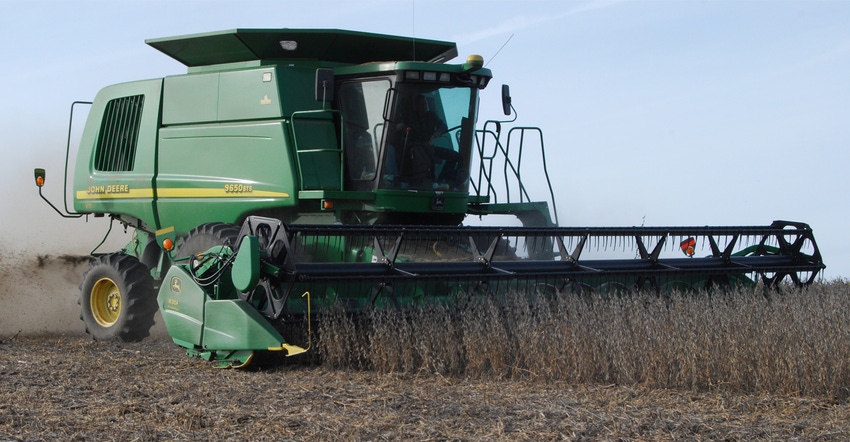September 21, 2020

A lot has happened in 2020 that brought out words or phrases most of us would just as soon never hear again, such as COVID-19, social distancing, drought and derecho. When 2021 arrives, these may still be relevant topics, unfortunately. The latter two will likely impact our fertilization plans for 2021, so let’s talk about ways to approach the fallout from drought and storm damage.
Drought across many areas has hit yields hard and created variability depending on if and when timely rains finally arrived. Storm damage — from hail to derecho winds — also hit hard this year, leading to wild yield swings within and between fields. Scouting in late July and early August hinted that yields will be all over the board. The largest stretch of green snap and wind damage that I’ve ever seen clearly illustrated we’d have even wilder yield variability well before harvest, unfortunately.
Stands in these wind-damaged fields ranged from moderate damage to complete crop loss, sometimes within the same field. We have variability every year but dealing with the wider yield swings in many places this fall can complicate things.
Fall fertilizer season
Fall fertilizer season is around the corner, and crop nutrition gives us a lot to think about. We already know yields are all over the place, and commodity markets are ugly. What are fertilizer prices doing now and what could they do? With all this to deal with, how do we approach soil sampling, fertilizer rates and budgets?
We need to get the most mileage out of fertilizer use. But in terms of phosphorus and potassium pricing, if you haven’t had a chance to get locked in for this fall, talk with your suppliers now. A quick snapshot of the fertilizer market shows as of mid-September, P and K are generally down 8% to 10% from a year ago across the Midwest. Local market conditions can cause pricing to deviate from these largescale trends, but from our perspective, hopefully, the bottom line is that fertilizer prices will remain stable or perhaps even weaken slightly this fall.
Optimizing fertilizer budgets
With corn and soybean markets in the tank for so long, we’re facing questions about how to get the most out of fertilizer dollars and maintain yield potential for several years. With some regions having yields pulled down by weather extremes in 2020, as well as some over the last few years, many farmers are wondering if they can count on carryover P and K for 2021 in lower-yielding areas.
Depending on yields and what recent soil tests show, there may be opportunities to trim back fertilizer applications in areas. The wide range of yield levels within many fields makes it more challenging, but good yield data and soil tests will help fine-tune fertility programs.
Data drives decisions
We’ll have yield data from the monitors (in harvestable fields), which provides the crop removal rates we may want to use in addition to our most important tool: soil tests. Most folks are probably on the same page as Iowa State University when it comes to soil testing, so we’ll just hit a few key points.
ISU recommends sampling soil every two to four years, or once in a crop rotation. Sampling every two years certainly provides a lot of information, but some farmers are comfortable with three- or four-year intervals. Rather than go to the time and expense of resampling everything after two years, some farmers spot-check a few areas in between sampling cycles. In a year like 2020, if through harvest you find some unusually higher- and lower-yielding areas, targeting these areas with new soil samples might provide more information to help maximize P and K dollars.
We have the data, now what?
So, we have good soil tests and yield maps, where do we go from here? Can we cut back on P and K application, do we need to maintain, or are we looking at low soil test levels that could limit yields?
ISU Extension publication PM-1688, A General Guide for Crop Nutrient and Limestone Recommendations in Iowa, lays it out in detail. The short version is the percentage of P and K applications expected on average to produce a yield response within each soil test category is 80% for very low testing soils, 65% for low, 25% for optimum, 5% for high and less than 1% for very high.
With high and very high testing soils having such low odds of a yield response, that’s a natural place to trim back fertilizer dollars if you keep an eye on soil tests.
With only a 25% chance of a yield response to P and K applications, skipping or cutting back on optimum testing acres is probably the largest opportunity for saving fertilizer dollars. If you have confidence in the soil sample results and they are well within the optimum ranges for P or K, trimming back on those acres for a year or two is a relatively low-risk proposition.
If they’re consistently toward the bottom end of optimum ranges, skipping or trimming for a year is probably still fine, just keep a closer eye on things. Spot checking, or better yet doing a full sampling of areas like this after next year’s crop, will guard against drawing levels down too far.
When we move to the low range of soil test results, odds of a yield response rise to 65%, and for very low test levels, the percentage moves to 80%. If there’s any doubt about having drawn soil test levels down into those ranges with more removal than what has been applied, and you can’t get new soil tests taken, strongly consider fertilizing for the 2021 crop and soil test ASAP next fall.
With yield maps, we can factor in the amount of fertilizer removed by crops harvested. This information isn’t always necessary if we have recent soil tests, but it can be useful. If we overlay recent soil test data, yield data and fertilizer applied since the soil tests were taken, it can paint a clearer picture of how much carryover we may have for 2021.
A few last details
Work with your local fertilizer dealer to set up variable-rate application equations that fit your needs. The basics start with applying fertilizer to soils testing low to very low, and skipping P or K application on areas testing high to very high. Fine-tuning what you want done with optimum testing soils and adjusting for the variability the yield maps show will, hopefully, be time well spent and offer some savings and better fertilizer efficiency.
Lastly, account for any other fertilizer sources, such as starter fertilizer or manure. Be sure to take the P and K credit from that source into account. Good luck the rest of the busy fall season and stay safe out there.
McGrath is the Extension coordinator for the Iowa Soybean Research Center at ISU. Email [email protected].
About the Author(s)
You May Also Like






